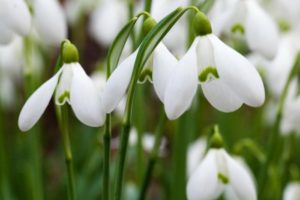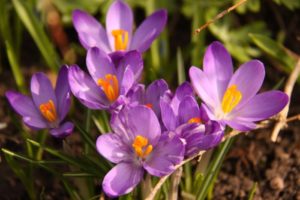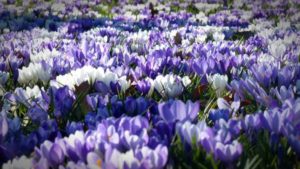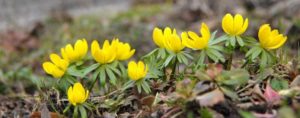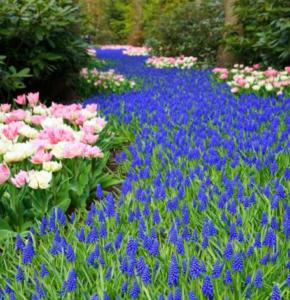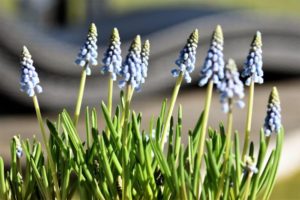Page 3
Galanthus
One of the first to bloom is snowdrops, with its nodding white flowers opening before winter snowstorms have moved on. They do well in partial shade to full sun and tolerate moist soil. And they’re deer-proof! Their thin leaves remain for a long period of time, so plant them where they won’t be overgrown by emerging foliage.
And resist prematurely cutting down the foliage because you want to plant annuals. Plant pansies, violas, or other cool-season annuals around or in front of them to disguise the ripening leaves, not bury them.
There are approximately 22 species of Galanthus, originating in Europe and the Middle East. Several varieties of the popular Galanthus nivalis and G. elwesii (Zones 3-8) are available, with small or larger green spots, and single or double petals. Galanthus plicatus ‘Wendy’s Gold’ and G. ‘Primrose Warburg’ have yellow highlights instead of green.
Established clumps in the Maryland gardens started blooming anywhere from the end of December to March. At no time was it necessary to protect them from harsh weather. They always popped back up after snow had laid them flat.
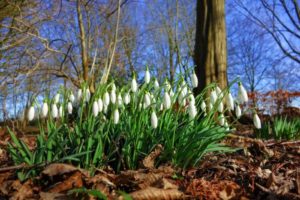
Snowdrops are perfect companions under shrubs or trees through a woodland garden. They grow less than 8″ tall, so plant them close to a path, or plant groups of the bulbs farther back.
In the Maryland garden, a colony of snowdrops under a Monarch birch tree (Betula maximowicziana) perfectly echoed the white bark of the tree. One of my favorites, charming, and a cute little cut flower in a tiny vase.
Crocus
Snow Crocus
Small-flowering species crocus (wild, snow, or botanical crocus; Zones 4-8) come up 2 or 3 weeks earlier than their large blooming Dutch cousins…not a minute too early for the bees!
I used to force these to bloom a bit earlier so they could be tucked into early spring pots with other minor (dwarf) bulbs, violas, pansies, young herbs, and perennials, all topped with a handful of moss. After the floral show was over, customers put the plants in the garden. Planted in color-coordinated pots, some of which were hand-made by my friend, Tez (“Pottery by Tez”), these tiny gardens were quick sellers at garden shows in Maryland and Virginia. Just adorable.
The varieties that I usually grew were ‘Cream Beauty’, ‘Blue Pearl’, ‘Tricolor’, ‘Lilac Beauty’, and ‘Ruby Giant’. Any leftovers from the shows were planted in customers’ gardens or added to mine.
Because they stay low to the ground, snow crocuses are often passed up by the deer in favor of something taller, like the heavily budded ‘Blaauw’s Pink’ azaleas. But, if you don’t want to take that chance, spray them with a deer repellent as soon as growth begins in late winter. If you don’t have any, try drizzling diluted milk around the flowers. They’re not fond of the smell of dairy. Dried blood also might turn them away.
Giant Dutch Crocus
These are so much fun to grow in the garden or forced in pots. Crocus bulbs (Zones 4-8), corms actually, are inexpensive, easily grown, long-lived, and good multipliers. Just watch out for the deer and rabbits; use barriers or deer repellents. In some years, the animals don’t bother them at all.
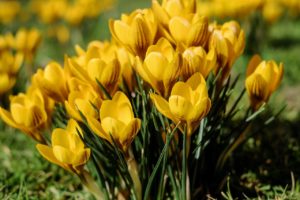
Crocus flowers are white, cream, pale yellow, golden yellow, orange, lilac, bluish-purple, or violet. They’re available in solid colors, or finely striped, feathered, or boldly marked in contrasting colors.
Plant them generously in shrub borders and along sidewalks or paths where they can be enjoyed up close. Dutch crocus grows a little taller than species crocus, to about 5″ tall. They bloom a couple of weeks after snow crocus. Because they multiply fairly fast, Dutch crocus bulbs planted in borders or bright woodlands will fill in nicely.
Varieties I’ve grown for many years include Crocus vernus ‘Flower Record’, ‘Jeanne d’Arc’, ‘Pickwick’, ‘Remembrance’, and ‘Yellow Mammoth’.
Eranthis
Four inch tall winter aconite (Zones 5-8), grown since the 1500’s, has lemon yellow flowers above a ruff of green foliage. Eranthis hyemalis grows in partial shade and prefers moist, rich soil. A patch of them in the garden lived for over 10 years, until they were shaded out by an expanding tree canopy. Deer didn’t bother it, and the early foraging bees visited when it bloomed in late winter to early spring.
Yellow is the first color our eyes see (think of school buses, caution lights), and commands attention in the garden. It adds warmth at a time of year when bleak skies and sudden snow squalls remind us that winter is not yet over.
Muscari
Grape hyacinths (Zones 4-8) have a fragrance reminiscent of…grape jelly! They make sweet cut flowers for a small bouquet. Leaves begin to grow in the fall, but they don’t need protection from cold weather. The deer, however, might nip them back. The long-lasting floral display begins in mid spring, and might require deer repellent.
If blue is your color, grape hyacinths are for you! You’ll find dozens of varieties in bulb catalogs or online, in white and every shade of blue and purple. There’s a newer, more expensive introduction called ‘Pink Sunrise’, which has pale pink flower buds that expand to a faint hint of color…delicate, and cute, tucked in next to a gray boulder.
Under a high tree canopy, consider planting a river of blue, as in the photograph, or begin with just a trickle.
Some varieties have lighter-colored buds near the tip of the spike, and others have a white edge on each floret. The catalogs list one, called M. macrocarpum ‘Golden Fragrance’, that has yellow flowers with a few purple florets on the tip.
Muscari varieties I’ve grown include ‘Valerie Finnis’, ‘Ocean Magic’, ‘Saffier’, ‘Dark Eyes’, ‘Pink Sunrise’, and the species, M. armeniacum. I’d like to try the larger M. paradoxum (Bellevalia pycnantha).
Muscari is another fast multiplier among the spring-flowering bulbs. Grape hyacinths grow into large clusters, which are easily lifted and divided when the foliage has yellowed in early to mid summer. It helps to mark the spots where the bulbs are growing thickly, and where they can be replanted.
Puschkinia
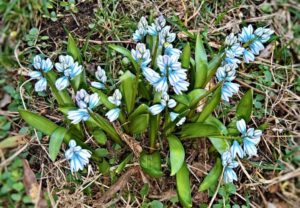
Another of the minor bulbs, striped squill (P. scilloides var. libanotica) grows only a few inches tall. Over the years, it can develop into extensive carpets of star-shaped white flowers with a sky blue stripe on the petals. Easy and deer-resistant. A variety called alba is almost pure white.
This plant multiplies freely, and is an easy one for shrub borders and bright woodlands. I planted a few bulbs near a purple beautyberry (Callicarpa). Within several years, the puschkinias covered the area under the shrub.
I often planted a low-growing annual called sweet alyssum on top of the bulbs. Annuals planted over bulb beds can benefit the bulbs by using up some of the moisture in the soil and by providing cool shade. By then, the bulbs are fully dormant and have no roots that need water.
Headings
Page 1: Time For Spring Flowering Bulbs, On the Subject of Tulips, How Bulbs Work, and First, a few words on summer- and fall-blooming bulbs (Elephant Ears, Caladium, Amaryllis, Colchicum Autumnale, Fall Crocus)
Page 2: Color Effects, Formal and Informal, Naturalizing in Lawns, Naturalizing in Meadows, If You’re New To Spring-Flowering Bulbs, When Planting Drifts of Bulbs (Microclimates and Timing, Laying Out the Beds), and Aftercare
Page 3: Galanthus, Crocus (Snow Crocus, Giant Dutch Crocus), Eranthis, Muscari, and Puschkinia
Page 4: Hyacinthoides, Tulipa (Tulips In Zones 7 and South, Species Tulips), Hyacinthus, Narcissus (Buying Daffodil Bulbs, Linnaeus, the RHS, and the ADS, Planting Daffodils, Fragrant Daffodils), and Allium
Page 5: Maintenance, Tricks to Hide Maturing Foliage, Stinzenplanten, Forcing Spring-Flowering Bulbs, Rock Gardens, and Don’t Overlook the Little Ones
